Marketing Process and Stages: LCBB4004 Report and Evaluation
VerifiedAdded on 2022/12/12
|8
|1944
|390
Report
AI Summary
This report provides a comprehensive overview of the marketing process and its various stages. It begins by defining marketing and emphasizing its importance in creating value for customers, stakeholders, and society. The report then delves into the core stages of the marketing process, including defining a company's mission, conducting situational analyses using SWOT and PEST frameworks, formulating marketing strategies based on target audience segmentation, and implementing the marketing mix (product, price, place, and promotion). The report also highlights the importance of control strategies and implementation approaches to ensure effective execution and monitoring of marketing efforts. The report concludes by summarizing the critical role of the marketing process in identifying opportunities, mitigating threats, and improving overall business operations. The report uses examples of Nike to illustrate the concepts discussed.

LCBB4004 : - Marketing
Fundamentals
Fundamentals
Paraphrase This Document
Need a fresh take? Get an instant paraphrase of this document with our AI Paraphraser
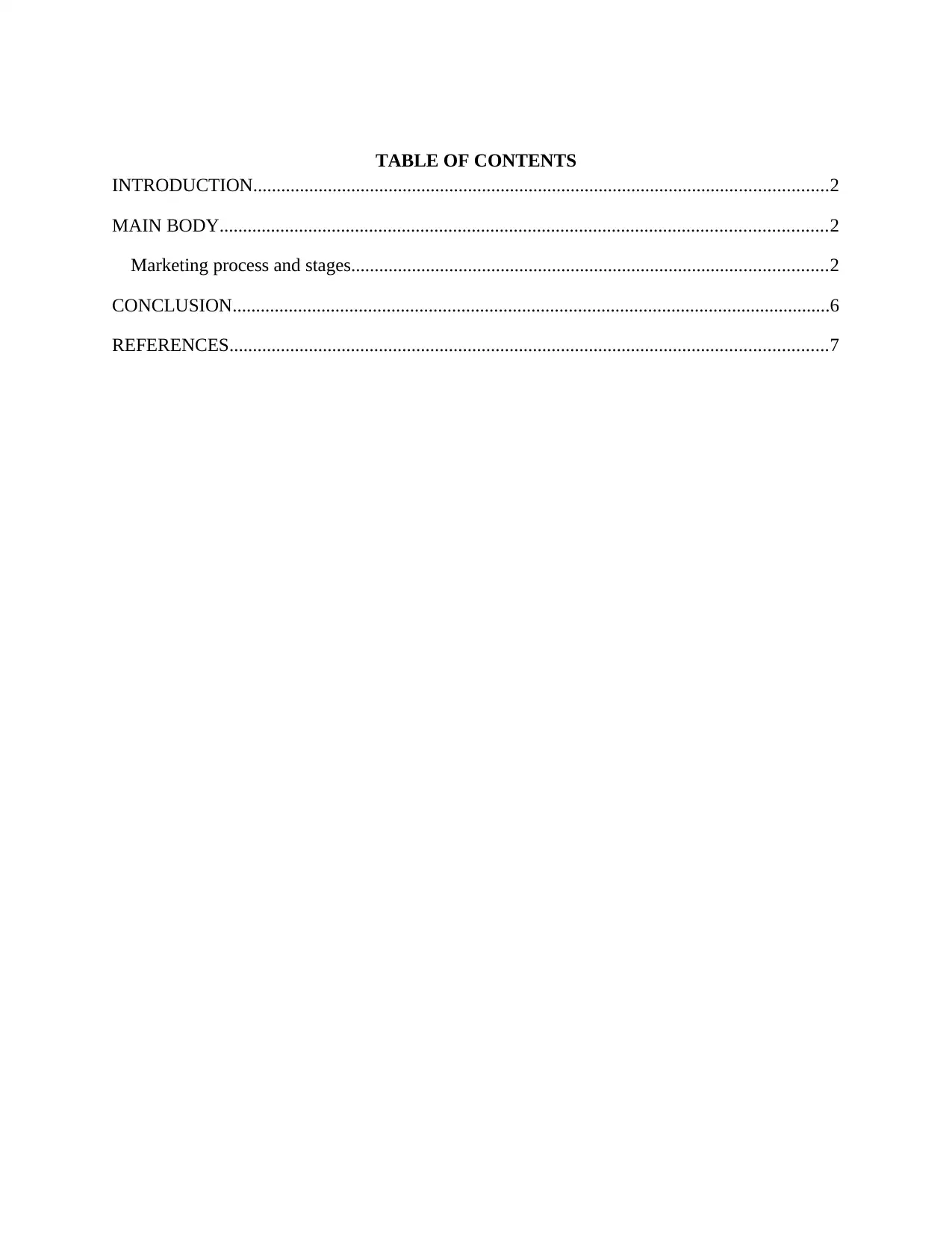
TABLE OF CONTENTS
INTRODUCTION...........................................................................................................................2
MAIN BODY..................................................................................................................................2
Marketing process and stages......................................................................................................2
CONCLUSION................................................................................................................................6
REFERENCES................................................................................................................................7
INTRODUCTION...........................................................................................................................2
MAIN BODY..................................................................................................................................2
Marketing process and stages......................................................................................................2
CONCLUSION................................................................................................................................6
REFERENCES................................................................................................................................7
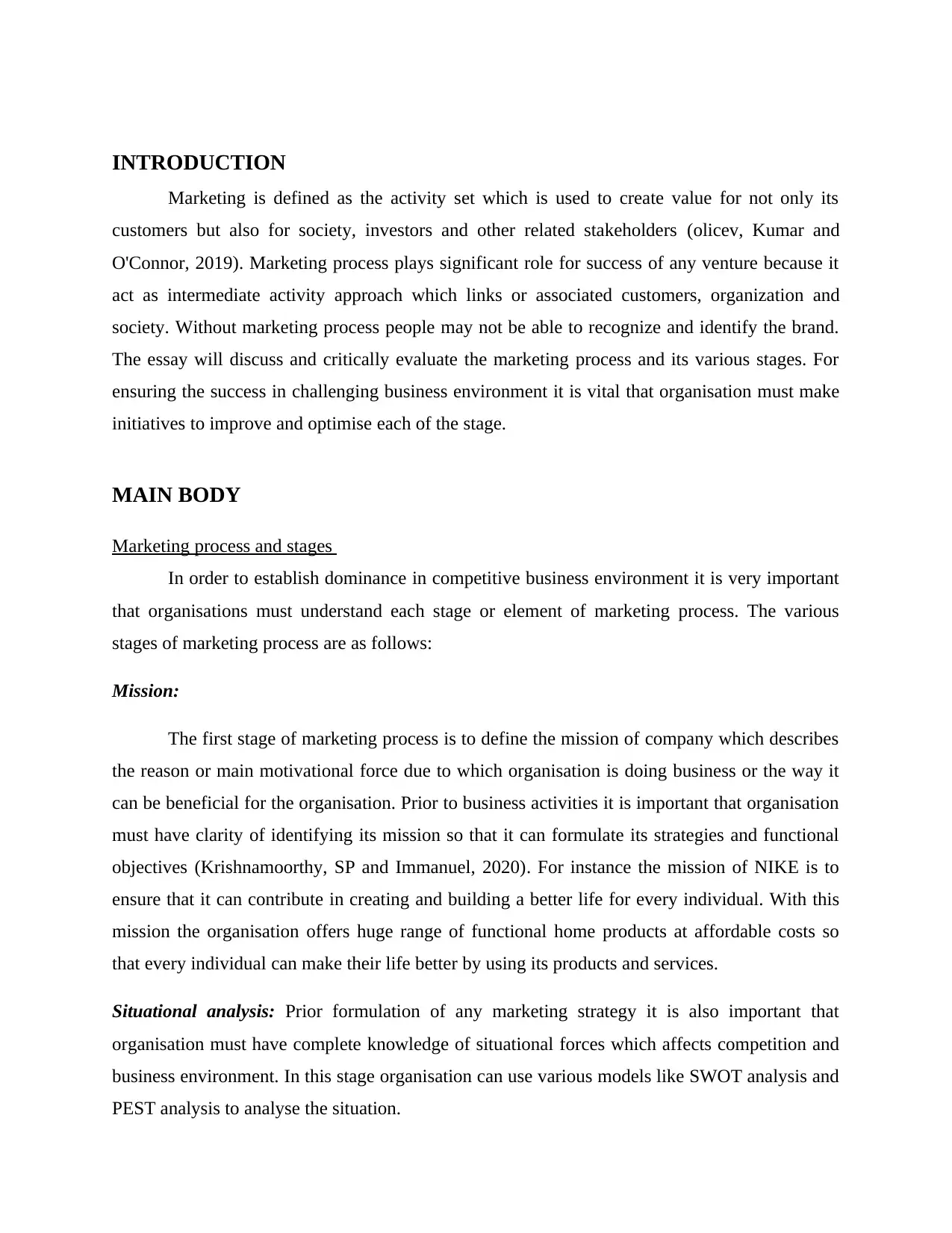
INTRODUCTION
Marketing is defined as the activity set which is used to create value for not only its
customers but also for society, investors and other related stakeholders (olicev, Kumar and
O'Connor, 2019). Marketing process plays significant role for success of any venture because it
act as intermediate activity approach which links or associated customers, organization and
society. Without marketing process people may not be able to recognize and identify the brand.
The essay will discuss and critically evaluate the marketing process and its various stages. For
ensuring the success in challenging business environment it is vital that organisation must make
initiatives to improve and optimise each of the stage.
MAIN BODY
Marketing process and stages
In order to establish dominance in competitive business environment it is very important
that organisations must understand each stage or element of marketing process. The various
stages of marketing process are as follows:
Mission:
The first stage of marketing process is to define the mission of company which describes
the reason or main motivational force due to which organisation is doing business or the way it
can be beneficial for the organisation. Prior to business activities it is important that organisation
must have clarity of identifying its mission so that it can formulate its strategies and functional
objectives (Krishnamoorthy, SP and Immanuel, 2020). For instance the mission of NIKE is to
ensure that it can contribute in creating and building a better life for every individual. With this
mission the organisation offers huge range of functional home products at affordable costs so
that every individual can make their life better by using its products and services.
Situational analysis: Prior formulation of any marketing strategy it is also important that
organisation must have complete knowledge of situational forces which affects competition and
business environment. In this stage organisation can use various models like SWOT analysis and
PEST analysis to analyse the situation.
Marketing is defined as the activity set which is used to create value for not only its
customers but also for society, investors and other related stakeholders (olicev, Kumar and
O'Connor, 2019). Marketing process plays significant role for success of any venture because it
act as intermediate activity approach which links or associated customers, organization and
society. Without marketing process people may not be able to recognize and identify the brand.
The essay will discuss and critically evaluate the marketing process and its various stages. For
ensuring the success in challenging business environment it is vital that organisation must make
initiatives to improve and optimise each of the stage.
MAIN BODY
Marketing process and stages
In order to establish dominance in competitive business environment it is very important
that organisations must understand each stage or element of marketing process. The various
stages of marketing process are as follows:
Mission:
The first stage of marketing process is to define the mission of company which describes
the reason or main motivational force due to which organisation is doing business or the way it
can be beneficial for the organisation. Prior to business activities it is important that organisation
must have clarity of identifying its mission so that it can formulate its strategies and functional
objectives (Krishnamoorthy, SP and Immanuel, 2020). For instance the mission of NIKE is to
ensure that it can contribute in creating and building a better life for every individual. With this
mission the organisation offers huge range of functional home products at affordable costs so
that every individual can make their life better by using its products and services.
Situational analysis: Prior formulation of any marketing strategy it is also important that
organisation must have complete knowledge of situational forces which affects competition and
business environment. In this stage organisation can use various models like SWOT analysis and
PEST analysis to analyse the situation.
⊘ This is a preview!⊘
Do you want full access?
Subscribe today to unlock all pages.

Trusted by 1+ million students worldwide
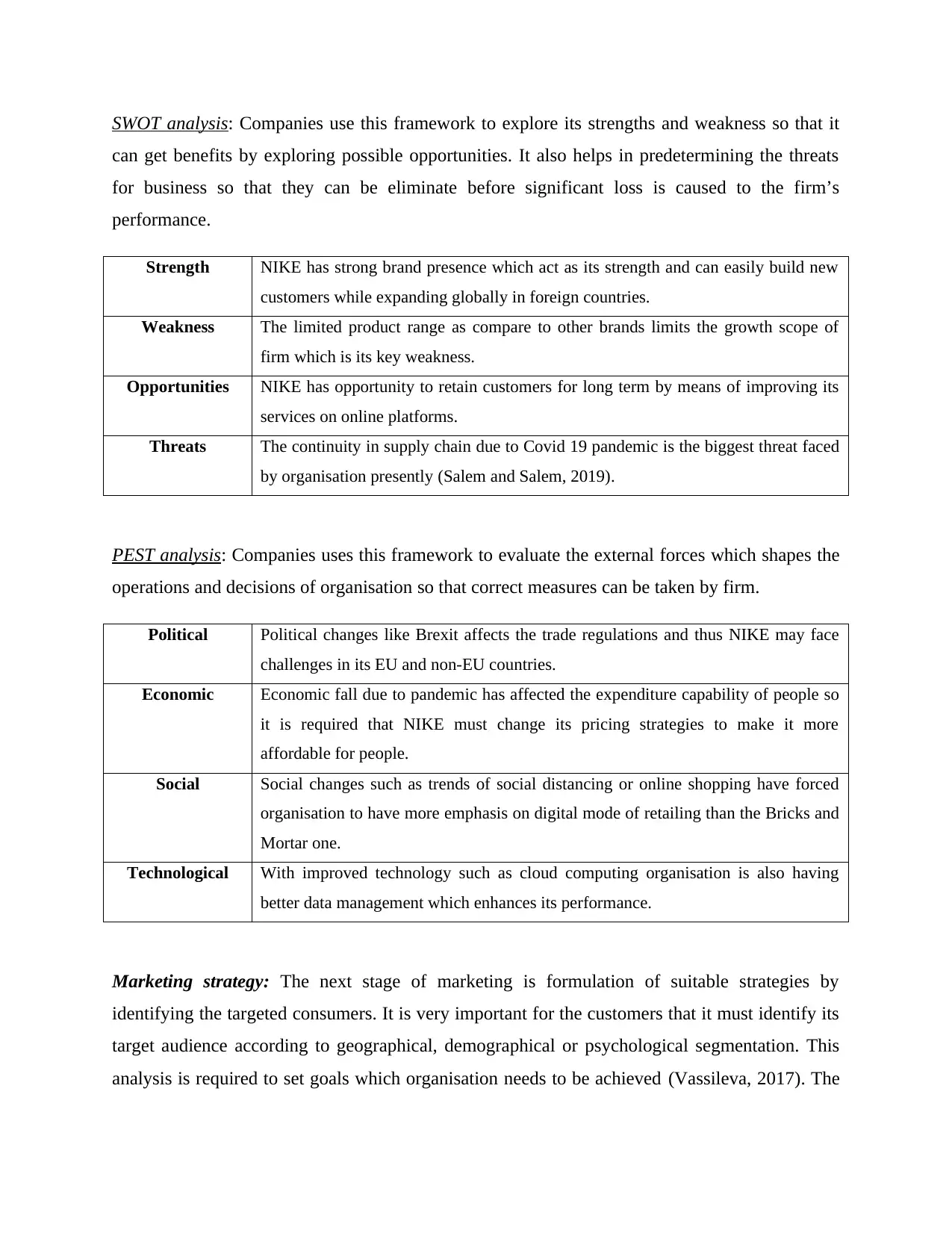
SWOT analysis: Companies use this framework to explore its strengths and weakness so that it
can get benefits by exploring possible opportunities. It also helps in predetermining the threats
for business so that they can be eliminate before significant loss is caused to the firm’s
performance.
Strength NIKE has strong brand presence which act as its strength and can easily build new
customers while expanding globally in foreign countries.
Weakness The limited product range as compare to other brands limits the growth scope of
firm which is its key weakness.
Opportunities NIKE has opportunity to retain customers for long term by means of improving its
services on online platforms.
Threats The continuity in supply chain due to Covid 19 pandemic is the biggest threat faced
by organisation presently (Salem and Salem, 2019).
PEST analysis: Companies uses this framework to evaluate the external forces which shapes the
operations and decisions of organisation so that correct measures can be taken by firm.
Political Political changes like Brexit affects the trade regulations and thus NIKE may face
challenges in its EU and non-EU countries.
Economic Economic fall due to pandemic has affected the expenditure capability of people so
it is required that NIKE must change its pricing strategies to make it more
affordable for people.
Social Social changes such as trends of social distancing or online shopping have forced
organisation to have more emphasis on digital mode of retailing than the Bricks and
Mortar one.
Technological With improved technology such as cloud computing organisation is also having
better data management which enhances its performance.
Marketing strategy: The next stage of marketing is formulation of suitable strategies by
identifying the targeted consumers. It is very important for the customers that it must identify its
target audience according to geographical, demographical or psychological segmentation. This
analysis is required to set goals which organisation needs to be achieved (Vassileva, 2017). The
can get benefits by exploring possible opportunities. It also helps in predetermining the threats
for business so that they can be eliminate before significant loss is caused to the firm’s
performance.
Strength NIKE has strong brand presence which act as its strength and can easily build new
customers while expanding globally in foreign countries.
Weakness The limited product range as compare to other brands limits the growth scope of
firm which is its key weakness.
Opportunities NIKE has opportunity to retain customers for long term by means of improving its
services on online platforms.
Threats The continuity in supply chain due to Covid 19 pandemic is the biggest threat faced
by organisation presently (Salem and Salem, 2019).
PEST analysis: Companies uses this framework to evaluate the external forces which shapes the
operations and decisions of organisation so that correct measures can be taken by firm.
Political Political changes like Brexit affects the trade regulations and thus NIKE may face
challenges in its EU and non-EU countries.
Economic Economic fall due to pandemic has affected the expenditure capability of people so
it is required that NIKE must change its pricing strategies to make it more
affordable for people.
Social Social changes such as trends of social distancing or online shopping have forced
organisation to have more emphasis on digital mode of retailing than the Bricks and
Mortar one.
Technological With improved technology such as cloud computing organisation is also having
better data management which enhances its performance.
Marketing strategy: The next stage of marketing is formulation of suitable strategies by
identifying the targeted consumers. It is very important for the customers that it must identify its
target audience according to geographical, demographical or psychological segmentation. This
analysis is required to set goals which organisation needs to be achieved (Vassileva, 2017). The
Paraphrase This Document
Need a fresh take? Get an instant paraphrase of this document with our AI Paraphraser
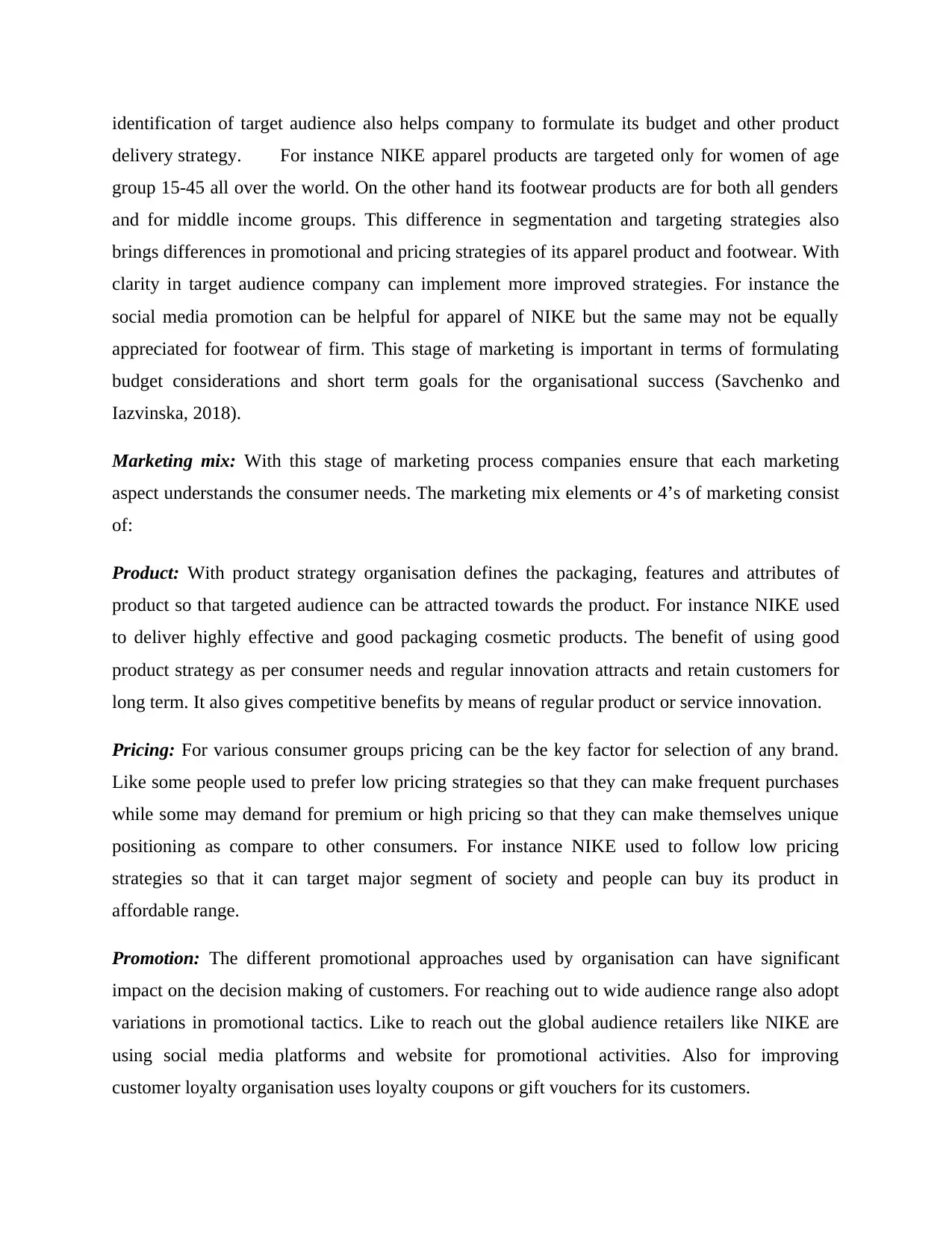
identification of target audience also helps company to formulate its budget and other product
delivery strategy. For instance NIKE apparel products are targeted only for women of age
group 15-45 all over the world. On the other hand its footwear products are for both all genders
and for middle income groups. This difference in segmentation and targeting strategies also
brings differences in promotional and pricing strategies of its apparel product and footwear. With
clarity in target audience company can implement more improved strategies. For instance the
social media promotion can be helpful for apparel of NIKE but the same may not be equally
appreciated for footwear of firm. This stage of marketing is important in terms of formulating
budget considerations and short term goals for the organisational success (Savchenko and
Iazvinska, 2018).
Marketing mix: With this stage of marketing process companies ensure that each marketing
aspect understands the consumer needs. The marketing mix elements or 4’s of marketing consist
of:
Product: With product strategy organisation defines the packaging, features and attributes of
product so that targeted audience can be attracted towards the product. For instance NIKE used
to deliver highly effective and good packaging cosmetic products. The benefit of using good
product strategy as per consumer needs and regular innovation attracts and retain customers for
long term. It also gives competitive benefits by means of regular product or service innovation.
Pricing: For various consumer groups pricing can be the key factor for selection of any brand.
Like some people used to prefer low pricing strategies so that they can make frequent purchases
while some may demand for premium or high pricing so that they can make themselves unique
positioning as compare to other consumers. For instance NIKE used to follow low pricing
strategies so that it can target major segment of society and people can buy its product in
affordable range.
Promotion: The different promotional approaches used by organisation can have significant
impact on the decision making of customers. For reaching out to wide audience range also adopt
variations in promotional tactics. Like to reach out the global audience retailers like NIKE are
using social media platforms and website for promotional activities. Also for improving
customer loyalty organisation uses loyalty coupons or gift vouchers for its customers.
delivery strategy. For instance NIKE apparel products are targeted only for women of age
group 15-45 all over the world. On the other hand its footwear products are for both all genders
and for middle income groups. This difference in segmentation and targeting strategies also
brings differences in promotional and pricing strategies of its apparel product and footwear. With
clarity in target audience company can implement more improved strategies. For instance the
social media promotion can be helpful for apparel of NIKE but the same may not be equally
appreciated for footwear of firm. This stage of marketing is important in terms of formulating
budget considerations and short term goals for the organisational success (Savchenko and
Iazvinska, 2018).
Marketing mix: With this stage of marketing process companies ensure that each marketing
aspect understands the consumer needs. The marketing mix elements or 4’s of marketing consist
of:
Product: With product strategy organisation defines the packaging, features and attributes of
product so that targeted audience can be attracted towards the product. For instance NIKE used
to deliver highly effective and good packaging cosmetic products. The benefit of using good
product strategy as per consumer needs and regular innovation attracts and retain customers for
long term. It also gives competitive benefits by means of regular product or service innovation.
Pricing: For various consumer groups pricing can be the key factor for selection of any brand.
Like some people used to prefer low pricing strategies so that they can make frequent purchases
while some may demand for premium or high pricing so that they can make themselves unique
positioning as compare to other consumers. For instance NIKE used to follow low pricing
strategies so that it can target major segment of society and people can buy its product in
affordable range.
Promotion: The different promotional approaches used by organisation can have significant
impact on the decision making of customers. For reaching out to wide audience range also adopt
variations in promotional tactics. Like to reach out the global audience retailers like NIKE are
using social media platforms and website for promotional activities. Also for improving
customer loyalty organisation uses loyalty coupons or gift vouchers for its customers.
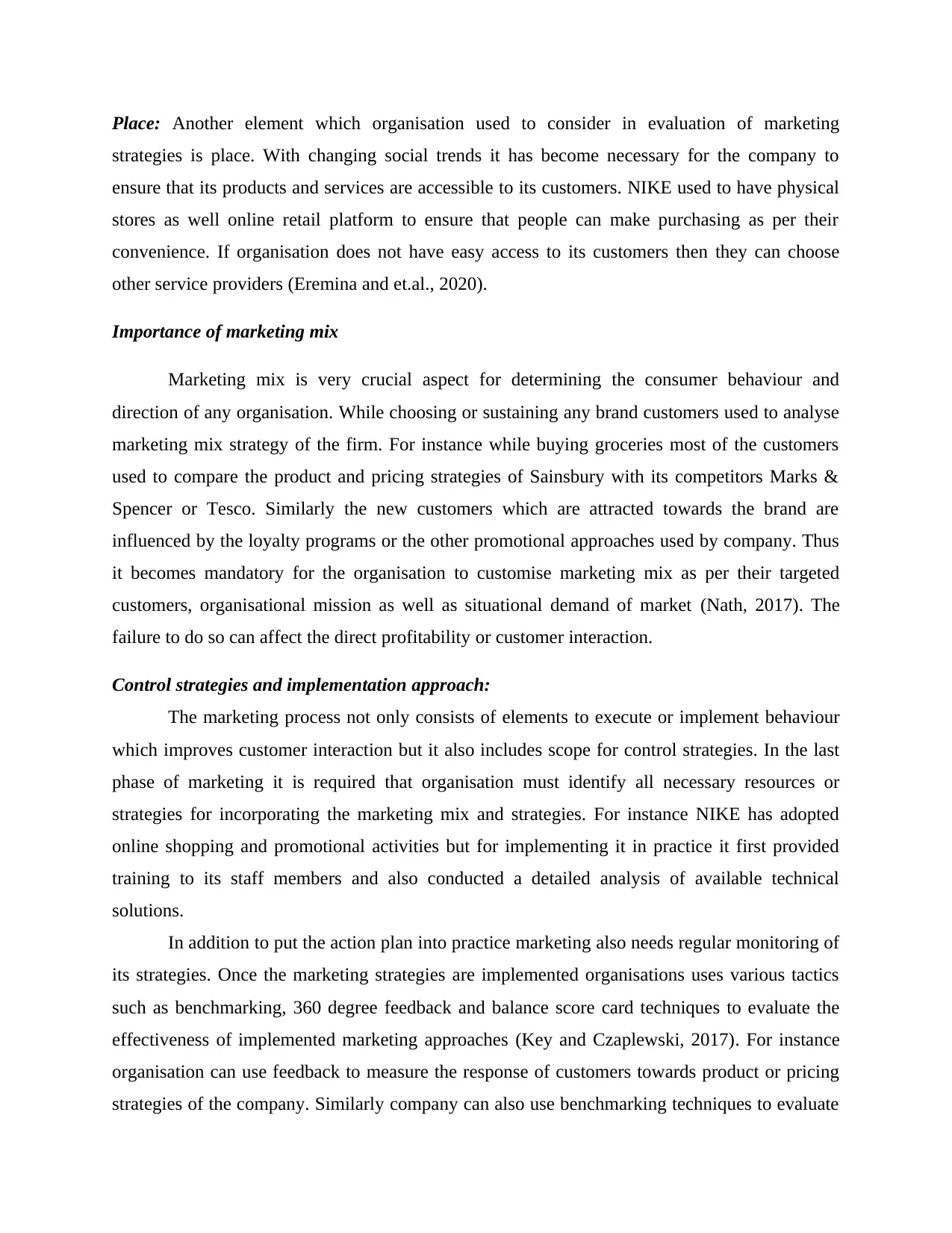
Place: Another element which organisation used to consider in evaluation of marketing
strategies is place. With changing social trends it has become necessary for the company to
ensure that its products and services are accessible to its customers. NIKE used to have physical
stores as well online retail platform to ensure that people can make purchasing as per their
convenience. If organisation does not have easy access to its customers then they can choose
other service providers (Eremina and et.al., 2020).
Importance of marketing mix
Marketing mix is very crucial aspect for determining the consumer behaviour and
direction of any organisation. While choosing or sustaining any brand customers used to analyse
marketing mix strategy of the firm. For instance while buying groceries most of the customers
used to compare the product and pricing strategies of Sainsbury with its competitors Marks &
Spencer or Tesco. Similarly the new customers which are attracted towards the brand are
influenced by the loyalty programs or the other promotional approaches used by company. Thus
it becomes mandatory for the organisation to customise marketing mix as per their targeted
customers, organisational mission as well as situational demand of market (Nath, 2017). The
failure to do so can affect the direct profitability or customer interaction.
Control strategies and implementation approach:
The marketing process not only consists of elements to execute or implement behaviour
which improves customer interaction but it also includes scope for control strategies. In the last
phase of marketing it is required that organisation must identify all necessary resources or
strategies for incorporating the marketing mix and strategies. For instance NIKE has adopted
online shopping and promotional activities but for implementing it in practice it first provided
training to its staff members and also conducted a detailed analysis of available technical
solutions.
In addition to put the action plan into practice marketing also needs regular monitoring of
its strategies. Once the marketing strategies are implemented organisations uses various tactics
such as benchmarking, 360 degree feedback and balance score card techniques to evaluate the
effectiveness of implemented marketing approaches (Key and Czaplewski, 2017). For instance
organisation can use feedback to measure the response of customers towards product or pricing
strategies of the company. Similarly company can also use benchmarking techniques to evaluate
strategies is place. With changing social trends it has become necessary for the company to
ensure that its products and services are accessible to its customers. NIKE used to have physical
stores as well online retail platform to ensure that people can make purchasing as per their
convenience. If organisation does not have easy access to its customers then they can choose
other service providers (Eremina and et.al., 2020).
Importance of marketing mix
Marketing mix is very crucial aspect for determining the consumer behaviour and
direction of any organisation. While choosing or sustaining any brand customers used to analyse
marketing mix strategy of the firm. For instance while buying groceries most of the customers
used to compare the product and pricing strategies of Sainsbury with its competitors Marks &
Spencer or Tesco. Similarly the new customers which are attracted towards the brand are
influenced by the loyalty programs or the other promotional approaches used by company. Thus
it becomes mandatory for the organisation to customise marketing mix as per their targeted
customers, organisational mission as well as situational demand of market (Nath, 2017). The
failure to do so can affect the direct profitability or customer interaction.
Control strategies and implementation approach:
The marketing process not only consists of elements to execute or implement behaviour
which improves customer interaction but it also includes scope for control strategies. In the last
phase of marketing it is required that organisation must identify all necessary resources or
strategies for incorporating the marketing mix and strategies. For instance NIKE has adopted
online shopping and promotional activities but for implementing it in practice it first provided
training to its staff members and also conducted a detailed analysis of available technical
solutions.
In addition to put the action plan into practice marketing also needs regular monitoring of
its strategies. Once the marketing strategies are implemented organisations uses various tactics
such as benchmarking, 360 degree feedback and balance score card techniques to evaluate the
effectiveness of implemented marketing approaches (Key and Czaplewski, 2017). For instance
organisation can use feedback to measure the response of customers towards product or pricing
strategies of the company. Similarly company can also use benchmarking techniques to evaluate
⊘ This is a preview!⊘
Do you want full access?
Subscribe today to unlock all pages.

Trusted by 1+ million students worldwide
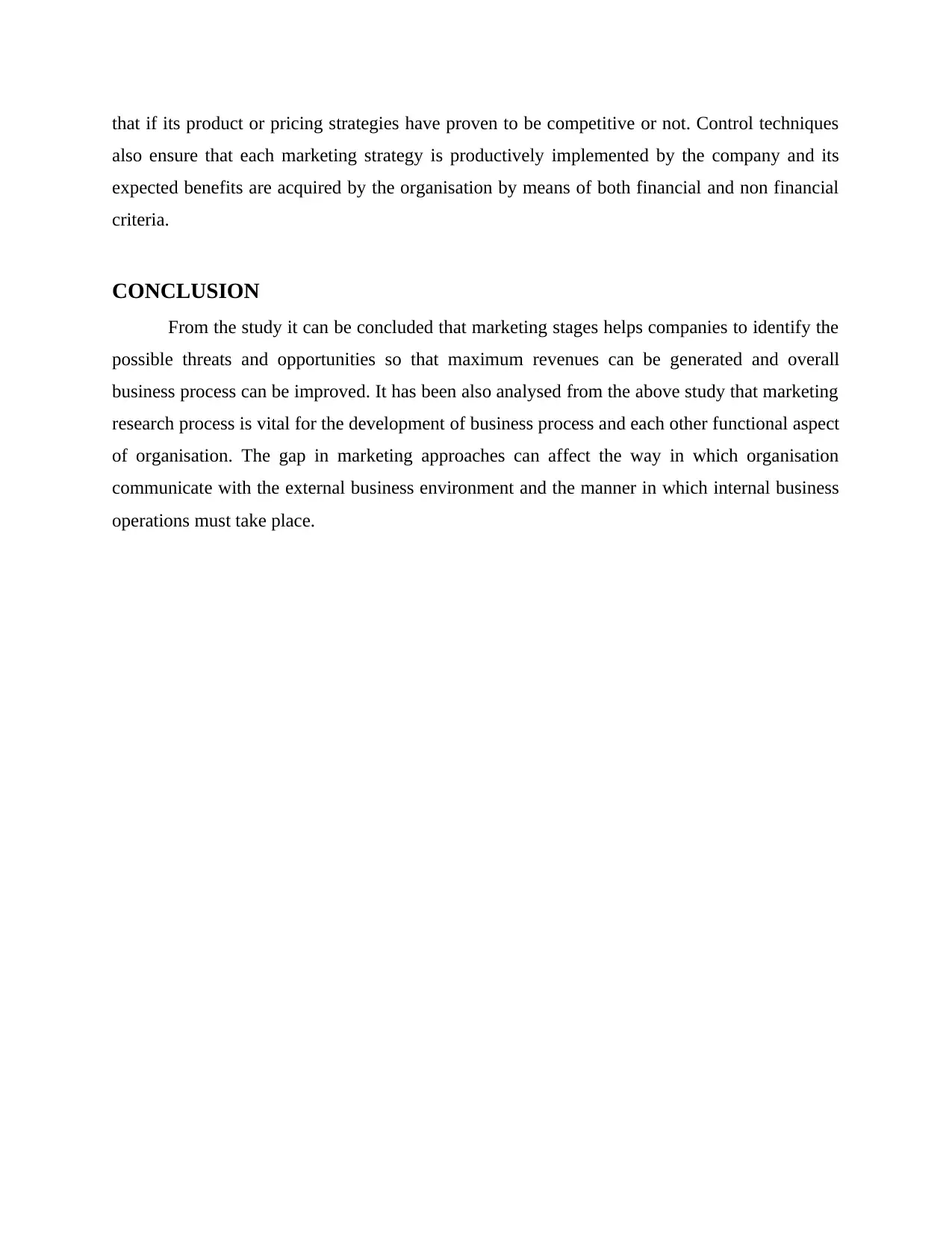
that if its product or pricing strategies have proven to be competitive or not. Control techniques
also ensure that each marketing strategy is productively implemented by the company and its
expected benefits are acquired by the organisation by means of both financial and non financial
criteria.
CONCLUSION
From the study it can be concluded that marketing stages helps companies to identify the
possible threats and opportunities so that maximum revenues can be generated and overall
business process can be improved. It has been also analysed from the above study that marketing
research process is vital for the development of business process and each other functional aspect
of organisation. The gap in marketing approaches can affect the way in which organisation
communicate with the external business environment and the manner in which internal business
operations must take place.
also ensure that each marketing strategy is productively implemented by the company and its
expected benefits are acquired by the organisation by means of both financial and non financial
criteria.
CONCLUSION
From the study it can be concluded that marketing stages helps companies to identify the
possible threats and opportunities so that maximum revenues can be generated and overall
business process can be improved. It has been also analysed from the above study that marketing
research process is vital for the development of business process and each other functional aspect
of organisation. The gap in marketing approaches can affect the way in which organisation
communicate with the external business environment and the manner in which internal business
operations must take place.
Paraphrase This Document
Need a fresh take? Get an instant paraphrase of this document with our AI Paraphraser
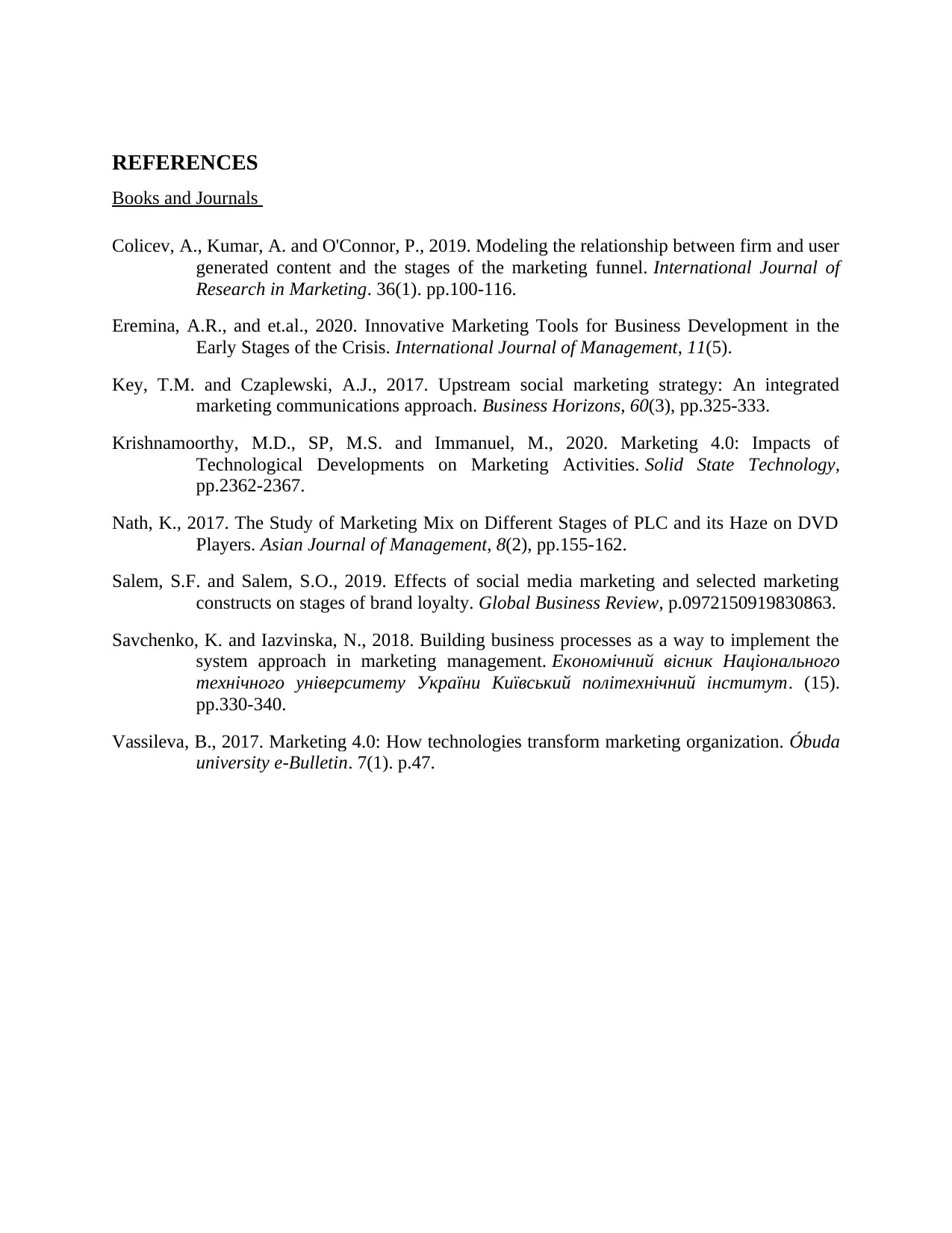
REFERENCES
Books and Journals
Colicev, A., Kumar, A. and O'Connor, P., 2019. Modeling the relationship between firm and user
generated content and the stages of the marketing funnel. International Journal of
Research in Marketing. 36(1). pp.100-116.
Eremina, A.R., and et.al., 2020. Innovative Marketing Tools for Business Development in the
Early Stages of the Crisis. International Journal of Management, 11(5).
Key, T.M. and Czaplewski, A.J., 2017. Upstream social marketing strategy: An integrated
marketing communications approach. Business Horizons, 60(3), pp.325-333.
Krishnamoorthy, M.D., SP, M.S. and Immanuel, M., 2020. Marketing 4.0: Impacts of
Technological Developments on Marketing Activities. Solid State Technology,
pp.2362-2367.
Nath, K., 2017. The Study of Marketing Mix on Different Stages of PLC and its Haze on DVD
Players. Asian Journal of Management, 8(2), pp.155-162.
Salem, S.F. and Salem, S.O., 2019. Effects of social media marketing and selected marketing
constructs on stages of brand loyalty. Global Business Review, p.0972150919830863.
Savchenko, K. and Iazvinska, N., 2018. Building business processes as a way to implement the
system approach in marketing management. Економічний вісник Національного
технічного університету України Київський політехнічний інститут. (15).
pp.330-340.
Vassileva, B., 2017. Marketing 4.0: How technologies transform marketing organization. Óbuda
university e-Bulletin. 7(1). p.47.
Books and Journals
Colicev, A., Kumar, A. and O'Connor, P., 2019. Modeling the relationship between firm and user
generated content and the stages of the marketing funnel. International Journal of
Research in Marketing. 36(1). pp.100-116.
Eremina, A.R., and et.al., 2020. Innovative Marketing Tools for Business Development in the
Early Stages of the Crisis. International Journal of Management, 11(5).
Key, T.M. and Czaplewski, A.J., 2017. Upstream social marketing strategy: An integrated
marketing communications approach. Business Horizons, 60(3), pp.325-333.
Krishnamoorthy, M.D., SP, M.S. and Immanuel, M., 2020. Marketing 4.0: Impacts of
Technological Developments on Marketing Activities. Solid State Technology,
pp.2362-2367.
Nath, K., 2017. The Study of Marketing Mix on Different Stages of PLC and its Haze on DVD
Players. Asian Journal of Management, 8(2), pp.155-162.
Salem, S.F. and Salem, S.O., 2019. Effects of social media marketing and selected marketing
constructs on stages of brand loyalty. Global Business Review, p.0972150919830863.
Savchenko, K. and Iazvinska, N., 2018. Building business processes as a way to implement the
system approach in marketing management. Економічний вісник Національного
технічного університету України Київський політехнічний інститут. (15).
pp.330-340.
Vassileva, B., 2017. Marketing 4.0: How technologies transform marketing organization. Óbuda
university e-Bulletin. 7(1). p.47.
1 out of 8
Related Documents
Your All-in-One AI-Powered Toolkit for Academic Success.
+13062052269
info@desklib.com
Available 24*7 on WhatsApp / Email
![[object Object]](/_next/static/media/star-bottom.7253800d.svg)
Unlock your academic potential
Copyright © 2020–2025 A2Z Services. All Rights Reserved. Developed and managed by ZUCOL.





